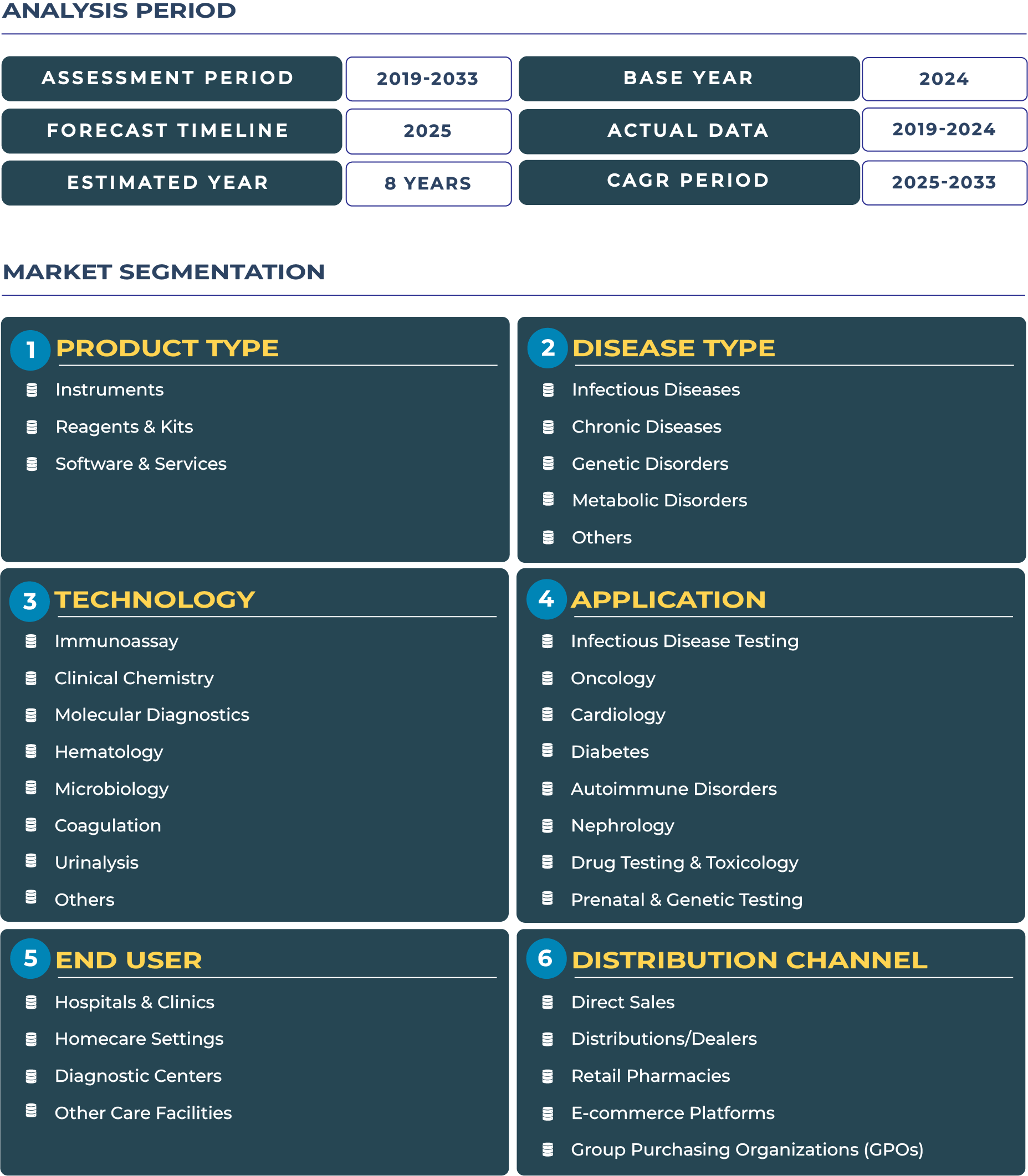Mexico In-vitro Diagnostic Market Outlook: Private Healthcare Penetration and Expanding Diagnostic Accessibility
The Mexico In-vitro Diagnostic market is projected to grow from USD 3.08 billion in 2025 to USD 7.01 billion by 2033, registering a CAGR of 10.8% between 2025 and 2033. This growth trajectory reflects a structural shift toward private healthcare investments and rising consumer preference for preventive testing. Private hospitals in cities such as Monterrey, Guadalajara, and Mexico City are modernizing their laboratories with automated analyzers, digital IVD platforms, and integrated software services. Meanwhile, affordable testing kits and reagents are increasingly used in secondary and provincial hospitals to extend access beyond metropolitan centers.
Additionally, policy alignment under the Secretaría de Salud and collaborations between local distributors and multinational firms are helping streamline diagnostic certification processes. While macroeconomic fluctuations and post-pandemic recovery continue to influence capital expenditure, the broader healthcare ecosystem remains resilient. Mexico’s economic stability and its medical tourism corridors have positioned it as one of the fastest-emerging markets for IVD technologies in Latin America.
Mexico’s Rising Medical Tourism and Its Ripple Effect on the In-vitro Diagnostic Market
Mexico has long been recognized as a regional healthcare hub, and its prominence continues to expand as medical tourism flourishes across Latin America. The nation’s affordability advantage and proximity to the United States have encouraged a consistent influx of patients seeking cost-effective, high-quality care. This momentum is now transforming the Mexico In-vitro Diagnostic (IVD) market, enabling both public and private institutions to invest in advanced diagnostic instruments and reagent systems that enhance patient outcomes. As Mexico’s middle class grows and private hospital networks expand, demand for accurate, timely, and cost-efficient diagnostics has surged, setting the stage for steady market growth through 2033.
Growth Drivers and Market Dynamics Strengthening Mexico In-vitro Diagnostic Sector
Expanding Private Hospital Infrastructure and Regional Diagnostic Demand
Mexico’s healthcare privatization wave has led to the rapid establishment of diagnostic labs and hospital networks catering to both domestic and international patients. The growing number of private healthcare groups and specialized clinics has created consistent demand for hematology, molecular diagnostics, and immunoassay analyzers. Furthermore, partnerships between hospitals and technology providers have introduced flexible procurement models and reagent rental programs, reducing upfront costs for smaller healthcare providers. These developments align with national strategies to strengthen healthcare service delivery and laboratory automation across the country.
Affordable Diagnostic Access Boosting Preventive Care Adoption
Preventive healthcare is gaining prominence as patients increasingly prioritize early disease detection. Affordable and rapid point-of-care testing kits are making diagnostics more accessible in peri-urban and rural zones. Initiatives by government institutions such as Instituto Mexicano del Seguro Social (IMSS) are driving awareness and adoption of IVD-based screening programs for chronic and infectious diseases. This rising acceptance of routine testing is translating into higher reagent consumption and service utilization rates, further supporting the IVD industry’s upward trajectory.
Regulatory and Logistical Challenges Affecting Market Momentum
Despite robust growth, several structural challenges hinder the Mexico IVD sector’s acceleration. Import tariffs, prolonged certification cycles, and supply chain constraints have increased operational costs for diagnostic manufacturers. Moreover, fragmented payer structures across public and private insurance schemes often delay reimbursement approvals for advanced diagnostic tests. These factors, coupled with limited equipment penetration in remote regions, continue to pose scalability challenges. However, ongoing regulatory modernization efforts are expected to streamline device approval timelines and improve accessibility over the forecast period.
Emerging Trends and Opportunities Reshaping the Diagnostic Ecosystem
Hospital Consolidation and Cross-Border Healthcare Flows
Mexico’s diagnostic landscape is experiencing consolidation as leading hospital groups form alliances to expand service portfolios. Cross-border healthcare flows from the United States, particularly from Texas, Arizona, and California, are fostering higher test volumes in northern Mexican states. These patient inflows have spurred private labs to adopt advanced instruments for molecular testing, genetic analysis, and infectious disease diagnostics. Additionally, digital connectivity and data-sharing platforms are improving interoperability, enabling faster diagnostic turnaround and better clinical decision-making.
Localization and Workforce Training as Future Growth Enablers
Opportunities are rising for domestic reagent manufacturing and localized software development to meet the specific requirements of Mexico’s hospital ecosystem. Local production can reduce dependency on imported kits and help manufacturers maintain competitive pricing in a cost-sensitive environment. Moreover, skill development programs in collaboration with public universities and healthcare associations are equipping provincial technicians with training in laboratory automation and molecular diagnostics. These efforts support Mexico’s long-term ambition to strengthen local manufacturing capabilities and human capital in the IVD sector.
Competitive Landscape: Strategic Partnerships and Product Localization Accelerating Growth
The competitive dynamics of the Mexico In-vitro Diagnostic industry are evolving as both local and international players expand their footprints. Global leaders such as Roche Diagnostics and Abbott Laboratories continue to strengthen their presence through partnerships with Mexican distributors to ensure efficient product delivery and compliance with national standards. Local firms are increasingly focusing on cost-optimized reagent kits and IT-integrated laboratory systems to attract mid-tier hospitals. Recent developments include the introduction of cloud-based laboratory information management systems that support integrated test data management and patient record accessibility across hospitals.
Collaborations between diagnostic manufacturers and healthcare providers are also fostering innovation in reagent optimization and workflow automation. These alliances not only address logistical challenges but also accelerate certification through shared regulatory expertise. As Mexico continues to refine its medical device regulations and promote clinical excellence, the IVD sector is poised for sustained expansion, driven by technology adoption, affordability, and expanding healthcare reach.







